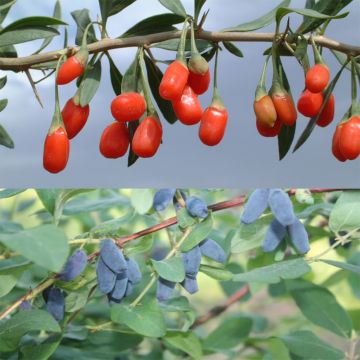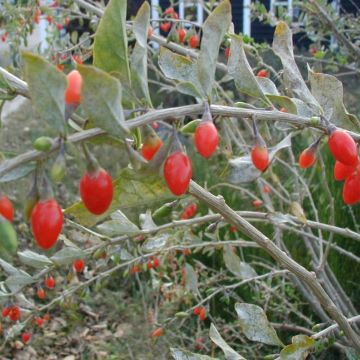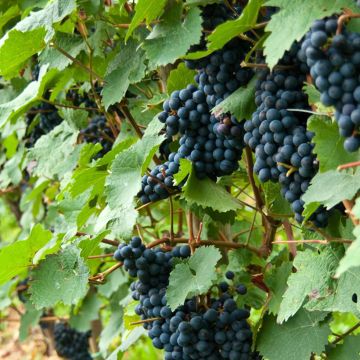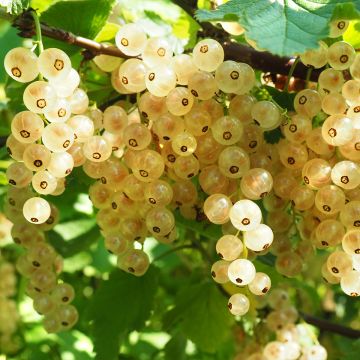

Lycium chinensis - Chinese Goji


Lycium chinensis - Chinese Goji


Lycium chinensis - Chinese Goji


Lycium chinensis - Chinese Goji
Lycium chinensis - Chinese Goji
Lycium chinense
Chinese boxthorn, Chinese wolfberry, Chinese matrimony-vine
Why not try an alternative variety in stock?
View all →This plant carries a 6 months recovery warranty
More information
We guarantee the quality of our plants for a full growing cycle, and will replace at our expense any plant that fails to recover under normal climatic and planting conditions.
Oversize package: home delivery by special carrier from €6.90 per order..
Express home delivery from €8.90.
Description
Lycium chinensis, commonly known as Goji or Chinese Boxthorn, is a deciduous shrub with bushy, slightly spiny, arching stems. In early summer tiny pink-purple flowers appear, which turn into oval, red-orange, sweet and tangy berries in early autumn. They have been known for their nutritional properties for millennia and are exceptionally rich in vitamins, minerals, and antioxidants. Hardy and easy to grow, it naturally forms a large clump, but it is best trained against a wall, fence, or other support and regularly pruned to facilitate berry picking.
Lycium chinensis (or Lycium chinense) belongs to the Solanaceae family, an important botanical family that includes many ornamental genera, such as Daturas, Brunfelsia, and Cestrum, as well as important food species in our diet, such as tomatoes and potatoes, or more anecdotal ones, like Physalis, the decorative and edible cape gooseberry. This is also the case with the Goji, a name shared with a close species, the Lycium barbarum or Common Boxthorn, native to the Mediterranean Basin.
Lycium chinensis is native to Asia, mainly China. It forms a bushy shrub with long, arching, trailing stems, giving it a spreading habit. An adult plant will reach approximately 1.80m (6ft) in height and 1.50m (5ft) in width. Being slightly spiny, it is wise to cultivate it against a wall, fence, or other support and prune it to limit its growth and facilitate berry picking. Its aesthetics are not particularly attractive, as it tends to thin out at the base and is quite frequently affected by powdery mildew, which gives its leaves a greyish-white downy appearance (without significantly affecting fruit production). The foliage is deciduous (absent in winter), bright green in young leaves, evolving to a greyish-green colour in mature leaves. The latter, of modest size, are elliptical and elongated, wider towards the base, and measure approximately 3-4cm (1-2in) in length by 1-2cm (0-1in) in width. Flowering occurs from June to July, sometimes in August, with small, tubular, campanulate, star-shaped, hermaphroditic flowers measuring 10mm (0in) in diameter, ranging from dark pink to purple. Self-fertile, the Chinese Boxthorn bears fruit after approximately 3 years of planting. The flowering is followed by the formation of ovoid berries, initially green and then ripening to orange, measuring about 18mm (1in) in length. These berries are edible when ripe, from September to October or November: it is preferable to consume dried berries, picked when fully ripe, when the solanine content has decreased in the pulp.
This small fruit is rich in carbohydrates and proteins, low in lipids. It is very rich in calcium, potassium, iron, selenium, vitamin E, vitamins B2, beta-carotene (which gives it its orange colour), and vitamin C (which enhances iron absorption by our body). The pulp of the Boxthorn has been the subject of numerous studies in recent years, which tend to prove its antioxidant properties.
Hardy, the Boxthorn can withstand temperatures as low as -20°C (-4°F). It can be integrated into ornamental gardens, trained against a trellis for example. It can also be part of a country hedge, along with redcurrants and flowering shrubs, or trained with garden blackberries. As it is quite resistant to drought and very hardy, it can be planted in most regions, and will adapt to the climate. It will simply be more productive if the soil remains slightly moist. Combine it with Zanthoxylum piperitum, the Sichuan pepper tree, whose spicy berries can be used in cooking, or with Cornus mas Schönbrunner Gourmet Dirndl, a male Cornelian cherry with small sweet red fruits.
Report an error about the product description
Lycium chinensis - Chinese Goji in pictures




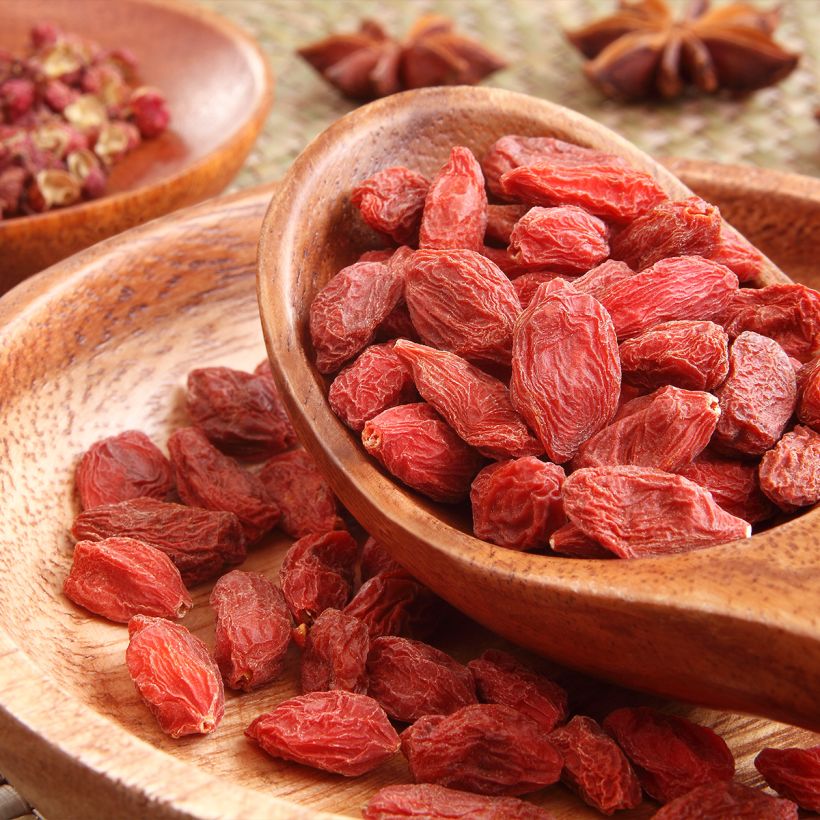

Plant habit
Fruit
Flowering
Foliage
Botanical data
Lycium
chinense
Solanaceae
Chinese boxthorn, Chinese wolfberry, Chinese matrimony-vine
China
Other Goji berry bush
Planting and care
Lycium chinensis prefers deep, preferably alkaline soils and requires a very sunny exposure to fruit well. It is a hardy plant, which can tolerate temperatures as low as -20°C (-4°F), but is susceptible to frost when still green and has not formed wood. At planting, dig a hole 50cm (20in) in all directions. In heavy soil, a layer of gravel or coarse sand should be laid down, followed by the original soil mixed with good quality compost and a bag of crushed horn. This plant can be grown as a bush in the ground or trained against a support, as it produces long woody climbing stems. Regular watering after planting is necessary to ensure good establishment. It takes a minimum of two years before a small harvest can be collected, and four years for a full harvest. The plant is self-fertile, meaning it does not require the presence of a mate of the opposite sex to fruit. Goji can be attacked by powdery mildew, a microscopic fungus that forms light, whitish spots on the leaves, without generally affecting fruit production. In case of a severe attack, it is possible to treat with sulphur, taking care to respect the pre-harvest interval.
Young Lycium plants show rapid growth in full sun, often several centimetres per week. Initially appearing to stretch, forming occasionally deformed leaves, they grow into their final, long and slender shape. To promote branching, it can be beneficial to pinch the top of the plant a few centimetres below the apex. This will help strengthen the plant's trunk and allow the emergence of several secondary branches, either at the base of the plant or at the point of pinching. It is advisable to prune each year after winter to prevent the base from becoming bare.
Planting period
Intended location
Care
This item has not been reviewed yet - be the first to leave a review about it.
Berries
Haven't found what you were looking for?
Hardiness is the lowest winter temperature a plant can endure without suffering serious damage or even dying. However, hardiness is affected by location (a sheltered area, such as a patio), protection (winter cover) and soil type (hardiness is improved by well-drained soil).

Photo Sharing Terms & Conditions
In order to encourage gardeners to interact and share their experiences, Promesse de fleurs offers various media enabling content to be uploaded onto its Site - in particular via the ‘Photo sharing’ module.
The User agrees to refrain from:
- Posting any content that is illegal, prejudicial, insulting, racist, inciteful to hatred, revisionist, contrary to public decency, that infringes on privacy or on the privacy rights of third parties, in particular the publicity rights of persons and goods, intellectual property rights, or the right to privacy.
- Submitting content on behalf of a third party;
- Impersonate the identity of a third party and/or publish any personal information about a third party;
In general, the User undertakes to refrain from any unethical behaviour.
All Content (in particular text, comments, files, images, photos, videos, creative works, etc.), which may be subject to property or intellectual property rights, image or other private rights, shall remain the property of the User, subject to the limited rights granted by the terms of the licence granted by Promesse de fleurs as stated below. Users are at liberty to publish or not to publish such Content on the Site, notably via the ‘Photo Sharing’ facility, and accept that this Content shall be made public and freely accessible, notably on the Internet.
Users further acknowledge, undertake to have ,and guarantee that they hold all necessary rights and permissions to publish such material on the Site, in particular with regard to the legislation in force pertaining to any privacy, property, intellectual property, image, or contractual rights, or rights of any other nature. By publishing such Content on the Site, Users acknowledge accepting full liability as publishers of the Content within the meaning of the law, and grant Promesse de fleurs, free of charge, an inclusive, worldwide licence for the said Content for the entire duration of its publication, including all reproduction, representation, up/downloading, displaying, performing, transmission, and storage rights.
Users also grant permission for their name to be linked to the Content and accept that this link may not always be made available.
By engaging in posting material, Users consent to their Content becoming automatically accessible on the Internet, in particular on other sites and/or blogs and/or web pages of the Promesse de fleurs site, including in particular social pages and the Promesse de fleurs catalogue.
Users may secure the removal of entrusted content free of charge by issuing a simple request via our contact form.
The flowering period indicated on our website applies to countries and regions located in USDA zone 8 (France, the United Kingdom, Ireland, the Netherlands, etc.)
It will vary according to where you live:
- In zones 9 to 10 (Italy, Spain, Greece, etc.), flowering will occur about 2 to 4 weeks earlier.
- In zones 6 to 7 (Germany, Poland, Slovenia, and lower mountainous regions), flowering will be delayed by 2 to 3 weeks.
- In zone 5 (Central Europe, Scandinavia), blooming will be delayed by 3 to 5 weeks.
In temperate climates, pruning of spring-flowering shrubs (forsythia, spireas, etc.) should be done just after flowering.
Pruning of summer-flowering shrubs (Indian Lilac, Perovskia, etc.) can be done in winter or spring.
In cold regions as well as with frost-sensitive plants, avoid pruning too early when severe frosts may still occur.
The planting period indicated on our website applies to countries and regions located in USDA zone 8 (France, United Kingdom, Ireland, Netherlands).
It will vary according to where you live:
- In Mediterranean zones (Marseille, Madrid, Milan, etc.), autumn and winter are the best planting periods.
- In continental zones (Strasbourg, Munich, Vienna, etc.), delay planting by 2 to 3 weeks in spring and bring it forward by 2 to 4 weeks in autumn.
- In mountainous regions (the Alps, Pyrenees, Carpathians, etc.), it is best to plant in late spring (May-June) or late summer (August-September).
The harvesting period indicated on our website applies to countries and regions in USDA zone 8 (France, England, Ireland, the Netherlands).
In colder areas (Scandinavia, Poland, Austria...) fruit and vegetable harvests are likely to be delayed by 3-4 weeks.
In warmer areas (Italy, Spain, Greece, etc.), harvesting will probably take place earlier, depending on weather conditions.
The sowing periods indicated on our website apply to countries and regions within USDA Zone 8 (France, UK, Ireland, Netherlands).
In colder areas (Scandinavia, Poland, Austria...), delay any outdoor sowing by 3-4 weeks, or sow under glass.
In warmer climes (Italy, Spain, Greece, etc.), bring outdoor sowing forward by a few weeks.


































